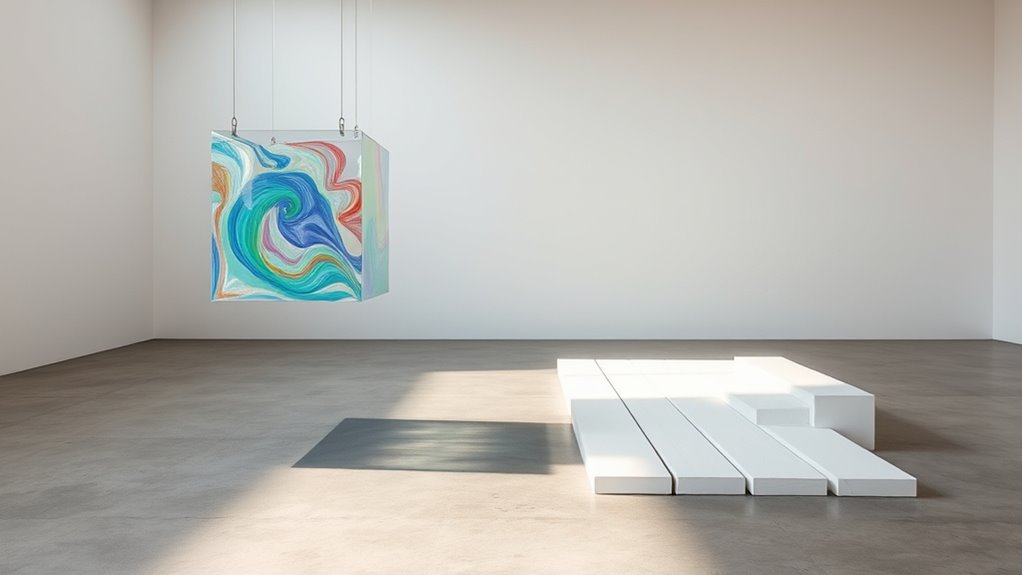Conceptual art is all about making ideas the core of the artwork. Instead of focusing on craftsmanship or aesthetics, you emphasize concepts, language, and instructions that challenge traditional art boundaries. Artists like Sol LeWitt and Joseph Kosuth use words, instructions, and everyday materials to provoke thought and participation. If you explore further, you’ll discover how this movement reshaped art, emphasizing ideas over objects and inspiring future creative approaches.
Key Takeaways
- In conceptual art, the idea or concept takes precedence over the physical artwork itself.
- Artists often use instructions, text, or documentation as the primary medium to convey ideas.
- The physical creation becomes secondary; the concept is considered the true artwork.
- This approach challenges traditional notions of craftsmanship and aesthetic value in art.
- The emphasis on ideas allows art to exist through processes, documentation, and audience participation.
The Origins and Evolution of Conceptual Art
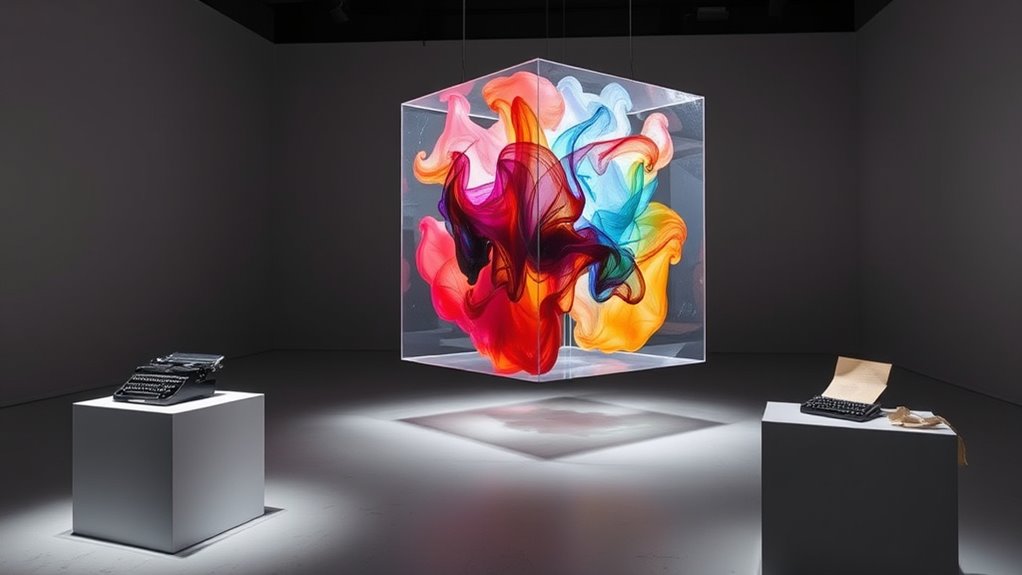
The origins of conceptual art trace back to early 20th-century avant-garde movements that challenged traditional notions of art. Marcel Duchamp’s readymades, like *Fountain* (1917), questioned what qualifies as art by emphasizing ideas over craftsmanship. As part of the Dada movement, Duchamp helped establish the groundwork by prioritizing concepts over the physical object, encouraging experimentation across different mediums. These pioneers blurred the lines between art and everyday life, rejecting conventional aesthetics. Their work was often rejected by mainstream art institutions, highlighting the need for new definitions. This rebellious spirit set the stage for the 1960s, when conceptual art emerged as a movement focused on ideas, language, and process, pushing the boundaries of artistic expression further than ever before. This shift in focus reflected a desire to explore the role of thought and concept as central elements of artistic practice. Emphasizing the importance of artistic ideas, the movement challenged audiences to reconsider what constitutes meaningful art. The evolution of this movement also demonstrates how the boundaries of art can be expanded by challenging traditional norms, encouraging innovation and dialogue within the cultural landscape. Additionally, the development of new mediums and techniques played a crucial role in expanding the possibilities of conceptual art, further emphasizing the importance of experimental approaches. For example, the use of language-based art like text pieces and instructions became prominent, demonstrating how conceptual art can incorporate diverse media and techniques, thus broadening its scope. This ongoing expansion showcases how the definition of art continues to evolve through innovative practices.
Core Principles and Defining Features

At the heart of conceptual art lies a focus on ideas rather than traditional aesthetics or craftsmanship. You prioritize the concept or message over the visual or material qualities, often using minimal or simple materials to convey your point. Planning is essential; you decide everything beforehand, making the physical execution secondary. This approach challenges norms, questioning art’s role as a skilled, tangible object. You may use any medium—text, instructions, photographs—to communicate your idea, emphasizing intellectual engagement. Language and documentation become art forms themselves, with written instructions or records playing key roles. You also critique the art world, exploring social or political issues through irony, satire, and audience participation. Additionally, the use of vetted materials and concepts ensures the integrity and safety of the work within the art context. Recognizing the importance of materials in maintaining credibility, conceptual artists often prioritize sustainability and ethical sourcing. Incorporating sound vibrations and scientific understanding can deepen the exploration of ideas, pushing the boundaries of conceptual practice. Ultimately, your work blurs boundaries between art and life, focusing on process, concept, and reflection rather than permanence or sensory pleasure.
Pioneering Artists and Their Contributions
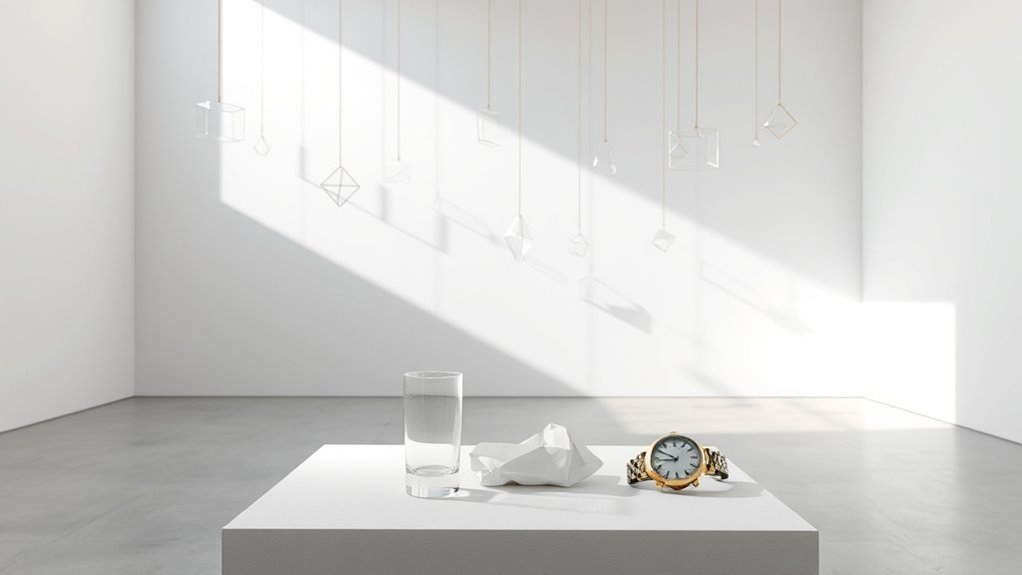
You’ll see how Sol LeWitt transformed ideas into art through his detailed instructions and minimalist structures. Joseph Kosuth focused on language as a primary medium, exploring how words and concepts shape our understanding of art. Their contributions pushed conceptual art toward emphasizing ideas, processes, and meaning over traditional craftsmanship. Their innovative approaches have demonstrated how conceptual art can challenge conventional notions of aesthetics and craftsmanship, shifting the focus to intellectual engagement. This emphasis on self-awareness highlights how conceptual artists encourage viewers to reflect on their own perceptions and interpretations. The Art Story has documented numerous pioneering artists in this movement, highlighting their innovative approaches and significance. Understanding the artistic process in conceptual art reveals how ideas are not just the starting point but the entire foundation of the work. Additionally, examining the role of instructions in artworks underscores how detailed guidance can serve as a core element, emphasizing the importance of ideas over physical execution. Recognizing the importance of diverse mediums in conceptual art demonstrates its capacity to incorporate various forms of expression beyond traditional materials.
Sol LeWitt’s Idea-Making
Have you ever considered that the core of a work of art might lie solely in its idea rather than its physical form? Sol LeWitt believed that art is fundamentally about ideas, not objects. He emphasized that the conceptual process and thought behind a piece define its value, freeing artists from traditional craftsmanship. By creating detailed instructions, LeWitt allowed others to execute his works, highlighting that the artist’s role is to conceive, not necessarily craft. This approach challenged notions of originality and authorship, shifting focus to the idea itself. His geometric, minimalist designs, based on simple shapes and patterns, exemplify clarity and intellectual engagement. LeWitt’s emphasis on idea-making transformed art’s definition, inspiring future generations to prioritize concepts over physicality, shaping the evolution of conceptual art. His work and ideas significantly influenced the transition from modern to postmodern art, emphasizing the importance of conceptual frameworks in artistic creation.
Joseph Kosuth’s Language Focus
Joseph Kosuth revolutionized conceptual art by emphasizing language as both the medium and subject of his work. You discover how he shifted focus from visual aesthetics to ideas, arguing that the artwork itself is the concept, not its physical form. By eliminating imagery and craftsmanship, he prioritized intellectual engagement, using words, definitions, and texts as his primary materials. His works, like “Five Words in Blue Neon,” challenge perceptions of language and color, while series like “Art as Idea as Idea” highlight art’s philosophical foundations. Influenced by Wittgenstein, Kosuth explores how language shapes understanding and constructs meaning. His appropriation of existing texts questions originality, emphasizing the circulation of ideas. Born in Toledo, Ohio, in 1945, through this approach, you see how language becomes a powerful tool for conveying and questioning artistic and philosophical concepts, demonstrating the significance of conceptual art. Additionally, his focus on art as idea underscores the importance of intellectual engagement over traditional craftsmanship, aligning with the mindfulness and presence techniques that foster deeper understanding of complex concepts.
Diverse Materials and Methods Employed

You’ll notice that conceptual artists often choose unconventional materials to challenge traditional ideas of art. They incorporate instruction-based methods, where the process or concept takes precedence over the finished piece. By doing so, they push boundaries and emphasize the importance of ideas over physical form. Furthermore, some artists explore generative AI techniques to create dynamic and evolving artworks that reflect complex ideas and user interactions. These innovative approaches often involve creative constraints that inspire new ways of thinking about artistic expression. Additionally, understanding support hours for various entertainment venues can provide artists and visitors alike with better planning opportunities, ensuring access during preferred times. Recognizing the importance of AI safety measures is essential as technology becomes more integrated into creative processes, safeguarding both creators and audiences.
Unconventional Material Use
What makes conceptual art stand out is its bold use of unconventional materials that challenge traditional boundaries. You’ll see artists transforming discarded objects like toys, newspapers, and metal scraps into intricate sculptures, emphasizing recycling and environmental themes. Found objects become powerful symbols, reimagined into new contexts. Unusual textiles, such as fabric made from bottle caps or reworked weaving, push the limits of traditional textiles, blending craft with conceptual ideas. Materials like coffee grounds, rusted metals, and natural elements introduce organic textures and symbolic depth. Artists also repurpose waste—plastic, test kits, and textile scraps—creating contemporary sculptures and jewelry that reflect current issues. These materials push boundaries, inviting you to rethink what counts as art, emphasizing ideas over conventional materials or techniques.
Instruction-Based Creations
Have you ever considered how instructions can transform simple ideas into complex works of art? In instruction-based creations, the focus shifts from craftsmanship to the power of ideas conveyed through precise directives. You might create art by following detailed instructions that emphasize concept over material, allowing for dematerialization and multiple interpretations. This approach enables artworks to be reproduced anywhere, challenging traditional notions of authorship and materiality. Artists often involve others in executing these instructions, fostering collaboration and variations, which questions who truly owns the work. Inspired by pioneers like Sol LeWitt and Marcel Duchamp, instruction-based art uses diverse media, from drawings to installations, to prioritize process and idea. Ultimately, it democratizes art, inviting participation and redefining what constitutes artistic labor and creativity.
Challenging Traditional Notions of Art

How does conceptual art challenge traditional ideas of what constitutes art? It shifts focus from craftsmanship and aesthetic beauty to the core idea behind the work. You’ll see that the execution often becomes secondary, with the idea acting as the “machine” producing the art. Anyone can create these works by following instructions, emphasizing the concept over skill. This approach questions the belief that art’s value depends on technical mastery or material beauty, often minimizing or eliminating physical presence altogether. Conceptual art also breaks boundaries by using everyday objects, nontraditional materials, and minimalist forms. It dismisses the idea that art must be beautiful or skillfully crafted, instead encouraging viewers to engage intellectually and rethink what art can be beyond conventional definitions.
The Role of Language and Instructions
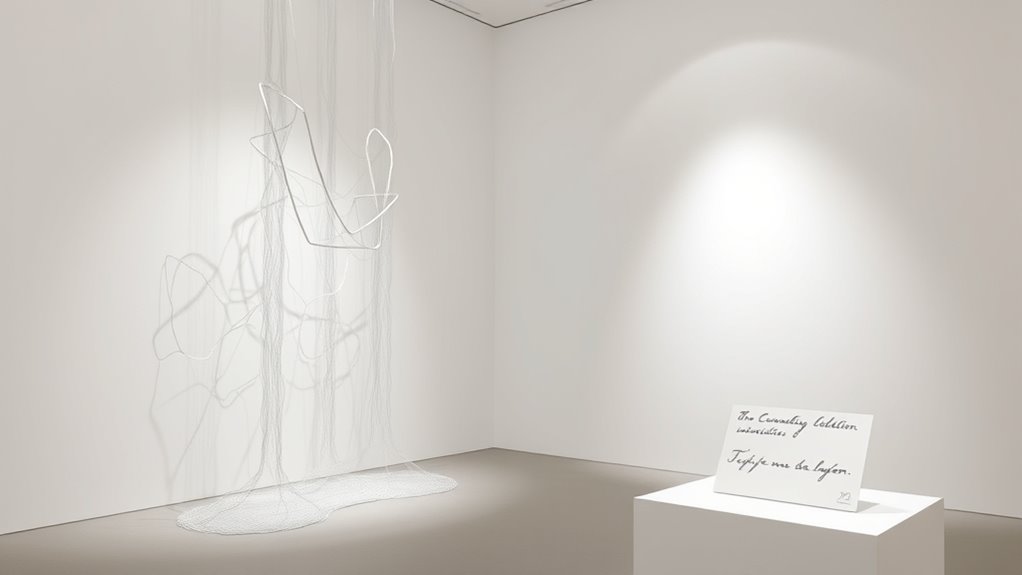
Language plays a crucial role in conceptual art by serving as the primary means for conveying ideas directly to viewers. It transforms art into a vessel for communication, often replacing visual forms with text or instructions. Your engagement might involve reading or following directives that shape the artwork’s meaning. Here are some key ideas:
- Using text to communicate concepts plainly and effectively
- Employing instructions to guide creation or interpretation
- Collaborating with assistants to realize ideas through specified steps
- Inviting viewers to participate or interpret based on provided guidelines
- Emphasizing the importance of the concept over physical aesthetics
Through these methods, language becomes a powerful tool to challenge traditional art, foster intellectual engagement, and blur the lines between art and philosophy.
Reception, Criticism, and Institutional Recognition

When conceptual art first emerged, it often faced confusion and skepticism from critics and audiences alike, who struggled to understand artworks that prioritized ideas over visual or technical skill. Many dismissed early works as lacking artistic skill, questioning if they even qualified as art. Public opinion was divided—some embraced its liberating nature, others saw it as antithetical to tradition. Media coverage was limited and often dismissive. Over time, institutional recognition grew through museum acquisitions, validating artists’ contributions and elevating their status. This shift transformed critiques: what was once marginalized became celebrated. As shown below, perceptions evolved:
| Aspect | Initial Reaction | Later Recognition |
|---|---|---|
| Public Perception | Confusion, skepticism | Appreciation, understanding |
| Media Coverage | Limited, skeptical | Increased, supportive |
| Artistic Value | Questioned, dismissed | Validated, celebrated |
| Institutional Role | Critical, outsider | Endorsing, mainstream |
| Legacy | Marginalized | Recognized, influential |
Influence on Contemporary Artistic Practices
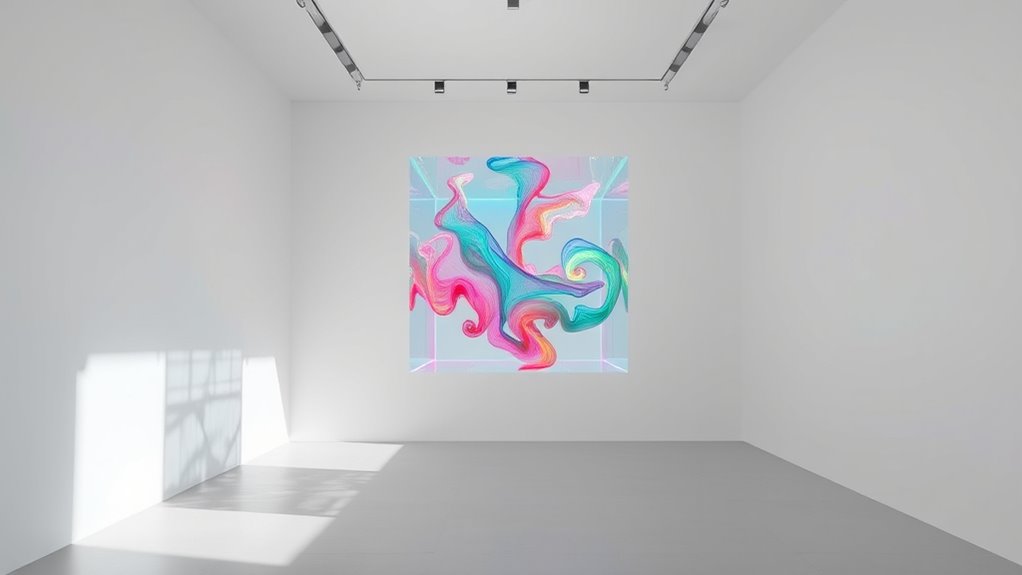
Contemporary conceptual art has profoundly shaped current artistic practices by integrating interdisciplinary methods, engaging viewers through participation, and critiquing societal institutions. You now see how artists combine philosophy, sociology, and other fields to craft complex ideas that challenge traditional art forms. Audience participation transforms viewers into active contributors, deepening their engagement. Digital technologies and new media expand the reach of conceptual works, making art more accessible and interactive. Societal issues are central, prompting dialogue and critical reflection on politics, institutions, and everyday life.
Contemporary conceptual art integrates interdisciplinary methods, encourages participation, and critically addresses societal issues.
- Employs interdisciplinary approaches
- Encourages audience participation
- Critiques societal and institutional structures
- Integrates digital and new media
- Addresses social and political themes
The Legacy and Future Directions

Conceptual art has left a lasting impact on art theory and philosophy by challenging traditional notions of aesthetic value and emphasizing the importance of ideas over physical objects. You’ve seen how it redefined art since the 1960s, encouraging critical discussions about authorship, originality, and the role of language. Its influence extends beyond visual arts into performance, installation, and digital media, shaping new ways for artists to communicate concepts. Museums and galleries now embrace ephemeral and idea-based works, transforming curatorial practices. The movement also inspires socially engaged and activist art, addressing issues like feminism and environmentalism. Looking ahead, conceptual art’s emphasis on ideas will continue to evolve, especially within digital spaces, fostering participatory practices and expanding art’s role as a platform for social discourse.
Frequently Asked Questions
How Does Conceptual Art Challenge Traditional Definitions of Artistic Skill?
You see, conceptual art challenges traditional ideas of artistic skill by prioritizing ideas over craftsmanship. Instead of focusing on technical ability, it uses everyday objects, text, or minimal materials to convey complex concepts. You don’t need traditional training or skill to create it—your focus shifts from aesthetic perfection to intellectual engagement. This approach questions what really makes art valuable, encouraging you to think beyond conventional notions of skill and beauty.
Can Conceptual Artworks Be Appreciated Without Physical or Visual Elements?
Imagine a thought floating freely like a cloud—can you grasp it without seeing or touching? Yes, you can appreciate conceptual artworks without physical or visual elements. Your mind becomes the canvas, engaging with ideas through reading, discussion, and reflection. The experience relies on your cognition, provoking deeper understanding and dialogue. It’s like a mental journey where the concept itself is the art, waiting for you to explore with your thoughts.
What Role Do Viewer Interpretation and Participation Play in Conceptual Art?
You play a crucial role in conceptual art by actively interpreting and participating. Instead of just observing, you engage intellectually, contemplating the ideas and forming your own understanding. Your personal background, experiences, and critical thinking shape how you perceive the work. This ongoing dialogue means your interpretation evolves over time, making the artwork dynamic and unique to you. Your participation transforms the art from a static object into a meaningful conversation.
How Do Instructions Influence the Creation and Understanding of Conceptual Pieces?
You might think instructions are simple guidelines, but in conceptual art, they’re the entire universe. They shape the creation process, transforming ideas into a reproducible blueprint anyone can follow. This turns the artist into a master architect of thought, making understanding and engaging with the work an active, mind-bending experience. As you interpret and recreate, you deepen your connection to the core concept, blurring the line between creator and spectator.
Is Conceptual Art Considered More Valuable Than Traditional Art Forms?
You might wonder if conceptual art is more valuable than traditional art. While traditional pieces like Van Gogh’s or Picasso’s often hold steady value due to their historical significance and craftsmanship, conceptual art’s worth comes from its ideas, cultural impact, and rarity. Market fluctuations exist for both, but traditional art generally maintains long-term investment appeal. Ultimately, value depends on personal preference, cultural relevance, and the art’s influence.
Conclusion
As you explore conceptual art, remember it’s all about ideas over aesthetics. Think of an artist instructing viewers to create their own piece from a simple phrase—like “thoughts in motion.” This invites you to participate, blurring the line between creator and audience. Conceptual art challenges you to see beyond the surface, making every idea a potential masterpiece. Embrace its transformative power—where your mind becomes the true canvas.

